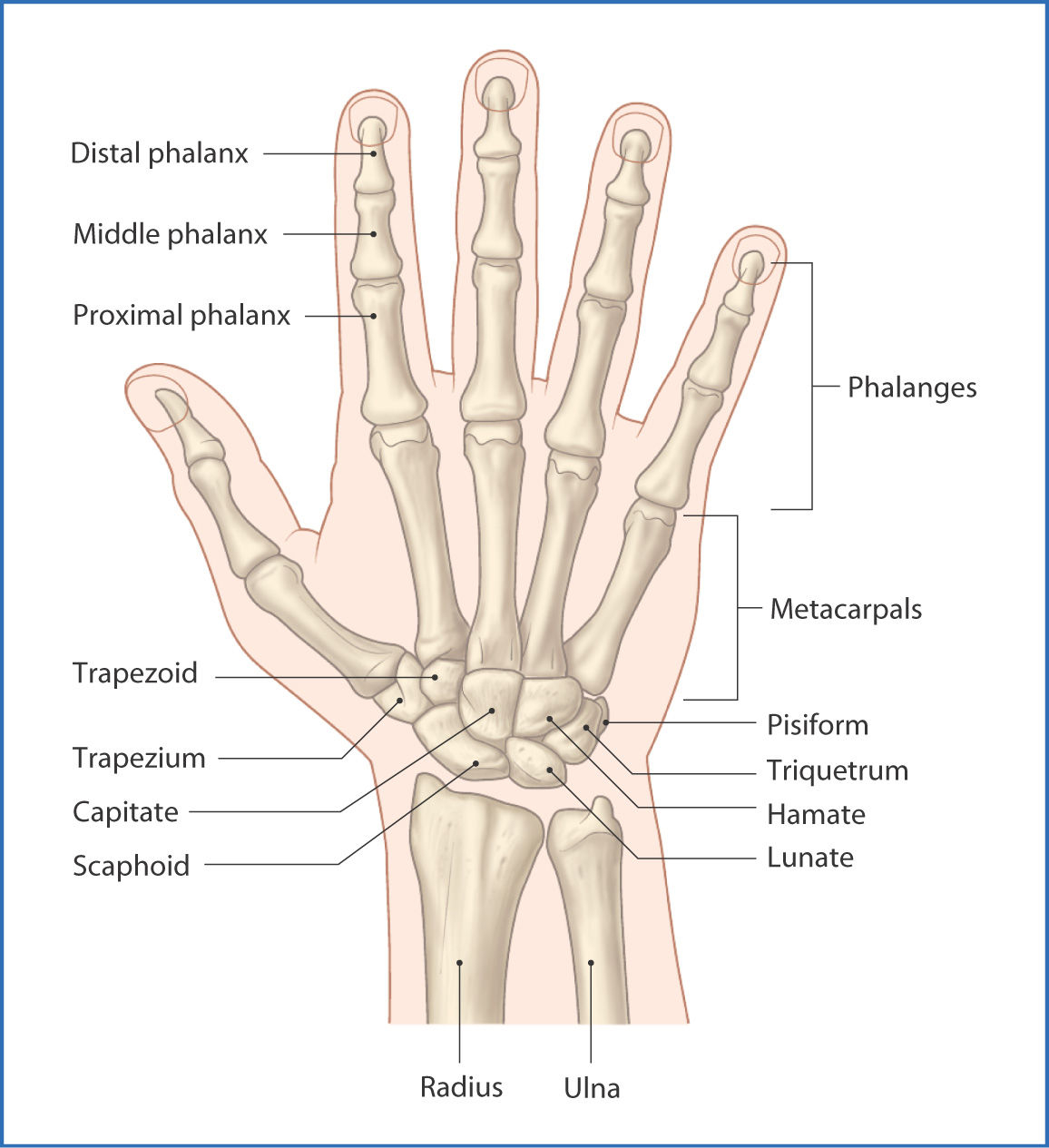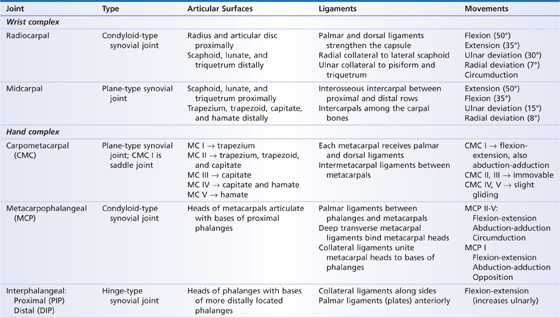
23
Wrist and Hand Joints
The joints of the wrists and hands consist of an array of small interconnections at the distal end of the upper limb that enable complex movements such as writing and sewing. The wrist contains 8 bones arranged in two rows (proximal and distal), whereas the hand and its five digits contain 19 bones (Figs. 23.1 and 23.2).

FIGURE 23.1 Bones of the wrist and hand, posterior (dorsal) view.

FIGURE 23.2 Ligaments of the wrist and hand, anterior (palmar) view.
Wrist
The eight carpal bones of the wrist are oriented in two rows and collectively connect the forearm to the hand. From lateral to medial, the first (proximal) row of bones in the wrist (carpal bones) comprises the scaphoid, lunate, triquetrum, and pisiform bones. The second (distal) row from lateral to medial comprises the trapezium, trapezoid, capitate, and hamate bones. The carpal bones form three primary articulations:
- wrist joint (radiocarpal joint) between the forearm and wrist
- midcarpal joints between the proximal and distal rows of carpal bones
- carpometacarpal joints between the distal row of carpal bones and the hand
- midcarpal joints between the proximal and distal rows of carpal bones
The carpal bones are contained within a single joint capsule that encloses the entire group. The joint capsule has many thickenings, which are named as ligaments (e.g., the palmar radiocarpal and ulnocarpal and dorsal radiocarpal and ulnocarpal ligaments and the ulnar and radial collateral ligaments of the wrist joint). In addition, interosseous intercarpal ligaments bind the proximal row of carpals with the distal row, and palmar and dorsal intercarpal ligaments connect the individual carpal bones within a row.
The scaphoid, lunate, and triquetrum bones within the joint capsule of the wrist form an arch that fits into a concave depression on the surface of the distal end of the radius. These bones articulate with the radius at the radiocarpal joint. The arch is bridged by the flexor retinaculum to form the carpal tunnel, through which pass the tendons of the flexor digitorum superficialis, flexor digitorum profundus, and flexor pollicis longus muscles and the median nerve.
On the dorsum of the wrist is the extensor retinaculum, which encloses the tendons on the dorsum of the hand to prevent bowstringing during extension of the wrist and hand.
Innervation of the carpal bones and joints is provided by the anterior interosseous nerve (a branch of the median nerve), the posterior interosseous nerve (a branch of the radial nerve), and the dorsal and deep branches of the ulnar nerve. The blood supply is from the dorsal and palmar carpal arches, which are formed from branches of the radial and ulnar arteries. Venous drainage is to the radial and ulnar veins through venae comitantes. Lymphatic drainage is to the cubital and axillary lymph nodes; there are no lymph node groups at the wrist.
Hand
The hand contains 19 bones divided into two groups, 5 metacarpals (which form the palm) and 14 phalanges (which form the fingers and thumb).
The metacarpals are slim bones with their heads distal and their bases proximal. The bases articulate with the carpal bones (Table 23.1) through carpometacarpal joints:
- The carpometacarpal joint of the thumb is between the base of metacarpal I and the trapezium.
- Metacarpal II articulates primarily with the trapezoid and secondarily with the trapezium and capitate.
- Metacarpal III articulates with the capitate.
- Metacarpal IV articulates with the capitate and hamate.
- Metacarpal V is medial in the hand and articulates with the hamate.
- Metacarpal II articulates primarily with the trapezoid and secondarily with the trapezium and capitate.
TABLE 23.1 Joints of the Wrist and Hand

Stay updated, free articles. Join our Telegram channel

Full access? Get Clinical Tree


